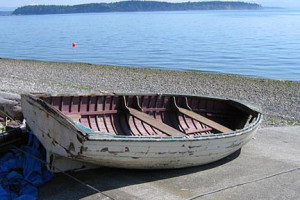Mukilteo Skiff
by Bill Haroldson (son-in-law of Rudolph Pallas)
Rudolph Pallas was born in 1900 in Phillips, Wisconsin, the third child and only son of Richard and Elise Pallas. In 1906 the family moved to Mukilteo, Washington where Richard found work with the Crown Lumber Company, a sawmill providing lumber for growing West Coast markets.
From an early age, Rudolph was fascinated by the sea and with the vessels that sailed to and from the Crown Lumber dock. Among them were steamboats of the Mosquito fleet that carried goods and passengers to all ports in Puget Sound, the steam tugs that towed large sailing ships into dock, and the windjammers that carried cargo to other major ports along the West Coast. He also remembered steam ships of the Dollar Line manned by white officers and Chinese crews dressed in skullcaps and pigtails.
The four-masted windjammer Rudolph particularly remembered was the Alice Cook because, at age fourteen, he persuaded her captain to sign him on as a cabin boy. Richard’s father quashed that plan, but only temporarily.
At sixteen, Rudolph joined his father in working at Crown Lumber. In less than a year he had saved enough to buy a boat of his own. He commissioned a man named Charley Valero to build a smooth-hulled wood skiff for him in 1917. Boats of this kind were common in Puget Sound. They were used for both salmon fishing and recreation. Rudolph used his to sail the length and breadth of Possession Sound to Whidbey, Hat, and Camano Islands. At first he hoisted a sail to ease his rowing labors. Later he purchased a Koban outboard motor, which he claimed was the first in Mukilteo.

In 1922 Rudolph joined the Coast Guard and was assigned to the revenue cutter U.S.S. Unalga. The ship’s primary mission was to enforce the 1911 convention on fur seals between the U.S., England, and Russia, but it also transported mail and supplies along the Alaskan and Canadian coastline. After only two years, Rudolph found work as a marine engineer with American Mail Line. His responsibility was to maintain the steam engines of the company’s President Liners that carried mail, goods, and passengers to and from the Orient. He served first on the President McKinley and subsequently on the President Jackson. Until 1936, when airplanes began to service this route, these liners were the only means of crossing the Pacific. Photos from the family album show Rudolph in a Chinese rickshaw, and downing a beer at Sloppy Joe’s Bar in Havana.
The President Quezon, formerly the President Madison, was being delivered to the Philippines in 1939 when it struck a reef off the south coast of Japan and sunk. Rudolph’s lifeboat capsized as it was being lowered from the ship, and he spent many hours in the cold water. Only after payment guarantees were made to the captain of a nearby Japanese vessel were he and his fellow shipmates rescued. One of the Americans died in the water. For the rest of his life, Rudolph believed the wreck was not an accident.
On his home stays, Rudolph continued to man his skiff around Possession Sound, making frequent camping trips to Whidbey Island. As the Island’s population grew, camping sites became harder to find. Rudolph purchased a waterfront property and began building a small cabin that he used on his clamming and fishing outings. Because there were no phones on Whidbey, Rudolph and his father worked out a signaling system that served him well. Whenever he was to report for duty, his father would hang a sheet from their chicken coop in Mukilteo. Rudolph could see this from atop a leaning alder outside his cabin, and he would know his beach days were at an end.
In his retirement, Rudolph and his wife Esther, their daughters Carolyn, Elissa, and Ann used the cabin for recreation. Still without electricity or running water, it gave the family a taste of early days. They pumped water from a well, cooked on a wood stove, and lit the cabin with kerosene lanterns. As no roads had yet been built, they had to hike down to the cabin from the ferry dock. When unable to walk in, Rudolph’s little skiff was commandeered to shuttle people back and forth.
By the late 1950s and 60s, Rudolph’s grandchildren began to come to the cabin, dig clams at low tide, and learn the name of the sea creatures on their beach. Rudolph would always remind them to “Never molest a large crab backing into the sand.” Like their grandfather before them, they enjoyed outings in the skiff.
Toward the end of the 1960s, the skiff was showing its age. The area where the stem and keel met was worn beyond use. Rudolph stored the boat in Seattle, where it often triggered memories. Many began, “Me and Francis Bemis rowed all the way to Hat Island, put up the sail and caught the north wind all the way back to Muk.”
Rudolph died in 1990, just prior to his 90th birthday. His boat of 73 years lives on however. In the summer of 2004, the family contacted the Northwest Wooden Boat Building School in Port Hadlock, Washington. One of the School’s missions is to preserve the design of boats unique to the Pacific Northwest. Graduates agreed to restore Rudolph’s skiff so that it could be displayed at the Mukilteo Museum, and took careful measurements in order to craft an exact replica of the original. The project is a tribute to boat builders of yesterday and today. The Pallas family is grateful to the School for preserving a piece of their family history as well as a fragment of our area’s maritime past.
More info can be found at:

